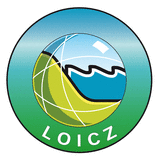Vietnam – Can Tho Province – Impervious Surface Cover, 2009
The map illustrates the results of remotely sensed estimations of impervious surface cover which can be defined as any surface cover that prevents the infiltration of water into the soil and is primarily associated with transportation (streets, parking lots, driveways, sidewalks etc.), building rooftops, and compacted soil. The legend on the right side of the map describes important map attributes, such as the colour scheme, scaling factor, two quicklook images of the data source and additional map information.
Impervious surface proportions were derived in a 10m*10m grid and resembled the spatial pattern of the prevailing settlement structures. The highest values (red) were predicted for the very densely built-up centre of Can Tho City and were comparatively low for the newly developed, residential districts located in the fringe areas or in the rural hinterland. Open spaces in the urban landscape covered by barren land or bare soil were mapped as low to middle imperviousness (yellow), while vegetated areas within the settlements were characterised by almost 0% imperviousness (green).

Figure 1 – Impervious Surface Cover 2009, Can Tho testsite.
Method: Impervious surface cover was estimated for settlement areas only, which were identified on the basis of single-polarized TerraSAR-X (TSX) data with a spatial resolution of 2.75 m. Thereby the distinct texture and the high density of dihedral corner reflectors prevailing in settlement areas were utilized by the use of an object-based image classification method.
The proportion of impervious surface cover was derived on the basis of a Support Vector Regression (SVR) model, which relates percent imperviousness to the spectral reflectance characteristics of SPOT 5 HRG data with 10 m resolution. The regression model was applied to SPOT 5 data from 2005 and 2009 which additionally formed the foundation for a change analysis and the calculation of average IS values for administrative units.
The results of the change analysis are illustrated in Figure 2. Increases of imperviousness (pink) could be attributed to new building and infrastructure constructions including also related bare soil areas. Decreases in imperviousness (green) could be solely attributed to bare soil areas related to construction activities in 2005 which were overgrown in 2009.

Figure 2 – Impervious Surface Change Map 2005-2009, Can Tho testsite.
Average impervious surface estimations on the commune level (Figure 3, left) ranged from very low values below 5% in the rural communes to peak values reaching up to 80% in the communes located in the centre of Can Tho City. Average increases in imperviousness (Figure 3, right) were highest (10%) in adjacent northern and western communes of the centre, where enough space was available for the development of residential areas. Furthermore, the map reveals a lot of construction activities along the western bank of the Mekong River, where new port facilities and industrial complexes have emerged.


Figure 3 – Average absolute impervious surface estimates for 2009, and increase in imperviousness between 2005-2009 on commune level; Can Tho testsite.
The analysis was produced by DLR for the WISDOM project. For more information please contact Dr. Claudia Kuenzer (claudia.kuenzer@dlr.de), project coordinator on the German side – October 2010.




